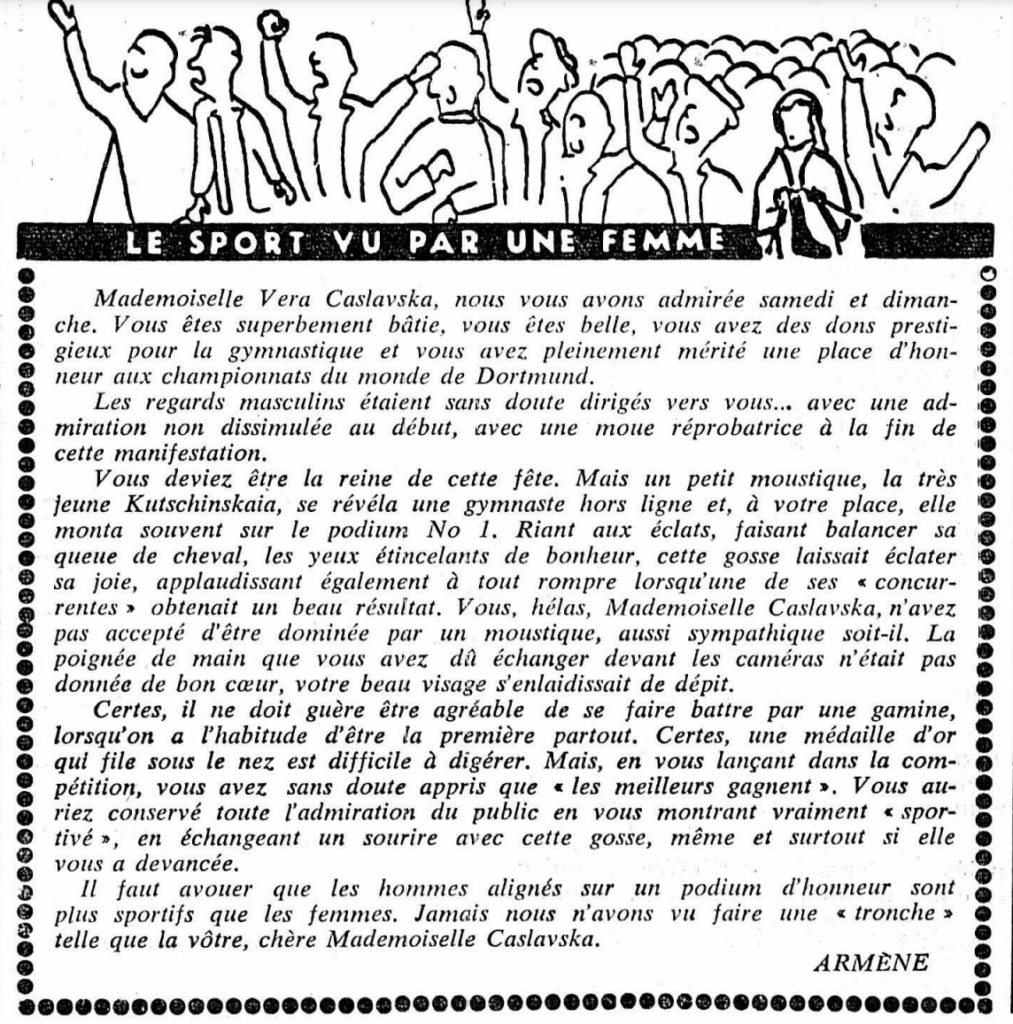Most gym nerds know about Věra Čáslavská’s political stance on the podium at the 1968 Olympics in Mexico City. (If you don’t, Google it. There’s plenty that has been written about it.)
But did you know that some saw tension between Čáslavská and the Soviet gymnasts already at the 1966 World Championships?
On October 1, 1966, the Feuille d’avis de Neuchatel published a column called “Le sport vu par une femme” (“Sports as Seen by a Woman”), chastizing Věra Čáslavská for her actions on the podium. Here’s what it said…

Miss Věra Čáslavská, we admired you on Saturday and Sunday. You are superbly built, you are beautiful, you have prestigious gifts for gymnastics, and you have fully earned a place of honor at the world championships in Dortmund.
The male gazes were undoubtedly directed towards you… with undisguised admiration at the beginning, with a disapproving frown at the end of this display.
You were to be the queen of this party. But a little mosquito, the very young Kuchinskaya, turned out to be an outstanding gymnast, and, in your place, she often climbed to the top of the podium. Laughing out loud, swinging her ponytail, eyes sparkling with happiness, this kid burst with joy, also applauding wholeheartedly when one of her “competitors” had a good result. You, alas, Miss Čáslavská, did not accept being dominated by a mosquito, no matter how nice a mosquito she is. The handshake that you had to exchange in front of the cameras was not given heartily, your beautiful face was ugly with annoyance.
Of course, it can’t be enjoyable to be beaten by a kid, when you are used to being first everywhere. Admittedly, a gold medal that is stolen right from under your nose is difficult to digest. But, by entering into the competition, you have no doubt learned that “the best win.” You would have retained the admiration of the public by showing yourself to be really athletic, by exchanging a smile with this kid, even if — and especially if — she was ahead of you.
It must be said that the men lined up on a podium of honor are more athletic than the women. Never have we seen a “mug” like yours, dear Miss Čáslavská.
There’s a lot wrong with this letter.
🥴 First, the idea that a female athlete’s goal is to be the object of the male gaze
🥴 Second, the idea that a female athlete must be smiling and cannot show disappointment
🥴 Third, the writer’s instinct to jump to conclusions and read into every single interaction between athletes
That said, there may be a morsel of truth to the writer’s interpretation of the events. There may have been tension brewing between Kuchinskaya and Čáslavská — at least on Čáslavská’s end.
In the newly published book Games of Discontent, Harry Blutstein writes:
Věra knew the Soviet gymnasts well. She had even struck up a friendship with Larisa Petrik; they would swap vinyl records when they were at the same competition and they enjoyed each other’s company. Věra, however, loathed Kuchinskaya, who she thought was vainglorious.
Blutstein doesn’t cite his source, so it’s unclear how he reached this conclusion.
Nevertheless, I don’t think that we should spend our time questioning whether Čáslavská purposefully snubbed Kuchinskaya or whether Čáslavská disliked Kuchinskaya. Maybe she did. Maybe she didn’t.
Instead, let’s situate this newspaper column in the broader historical context of the sport.
What can we take away from this column?
A Long History of Interpreting Podium Interactions
The column illustrates how much gym nerds read into podium interactions. This certainly wouldn’t be the first time that gym nerds would read meaning into the podium interactions between two gymnasts. There’s a long history of it in our sport.
For example, at the 1991 World Championships, many felt that Boginskaya snubbed Zmeskal when Boginskaya didn’t shake Zmeskal’s hand on the podium (Baltimore Sun, Sept. 16, 1991). (Boginskaya clarified what happened in an episode of GymCastic.)
A Long History of Expected Smiles
More importantly, this column illustrates that the expectations of female gymnasts (and female athletes, in general) have not changed in decades.
In fact, past presidents of the Women’s Technical Committee have favored gymnasts who smile and express joy.
Two quick examples:
Berthe Villancher, discussing choreography and the 1968 Code of Points
“If the musical phrase is serious, it is not necessary for the girl to look as though she were about to lose her family. The floor exercise, on the contrary, represents a joy, an expulsion, of the human body which expresses in all its possibilities what the musical phrase expresses. It is consequently a joy and not a theatrical drama.” (Mademoiselle Gymnast, May/June 1968).
Nellie Kim, discussing the weaknesses of the Russian women’s team in 2013
“Compare Komova to the American Maroney. They are the same age. Vika’s gymnastics is more beautiful and cleaner. But her rival enters the arena and flies, smiles. I think that the American girls often beat the Russians thanks to their positive vitality. The judges like polite, smiling gymnasts.”
We’ll discuss Villancher’s views on the 1968 Code of Points at length in the future. They were… umm… controversial.
In the meantime, look forward to a less controversial quiz about the 1966 World Championships. Start studying!